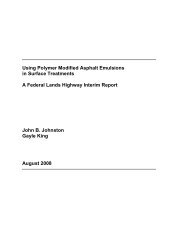Handbook for Bridge Inspections - TSP2
Handbook for Bridge Inspections - TSP2
Handbook for Bridge Inspections - TSP2
Create successful ePaper yourself
Turn your PDF publications into a flip-book with our unique Google optimized e-Paper software.
* The density of the concrete in relationship to the transfer of oxy<br />
gen (quality of the concrete, thickness of the cover).<br />
* The electrochemical properties of the concrete (variation in its<br />
qual ity, high mo isture content, possible presence of macro<br />
cells).<br />
Chl oride can penetrate concrete via three different sources:<br />
* Embedded chloride<br />
* Defrosting sa lt<br />
* Mari ne climate<br />
Embedded Chloride<br />
This can be found in older bridges due to the lise of sea water<br />
during construction, or aggregate or setting agent containing chloride.<br />
The use of sea water and aggregate dredged from the sea<br />
were previously acceptable and can still be found in several older<br />
coastal bridges.<br />
Calcium chloride (CaCI) is used as a setting agent especially by<br />
the concrete casting industry to allow casts to be speedily released<br />
<strong>for</strong> reuse. Elements so cast can be found, <strong>for</strong> example, on the<br />
underside of bridge decks supported on steel plates where the brid·<br />
ge deck is partially prefabricated.<br />
Embedded chloride produces a flat chloride profile deep within<br />
concrete. The chloride profile can be overlaid by chloride which<br />
has penetrated from outside the concrete. A further effect of carbo·<br />
ni sation wi ll be a reduction in the concrete's ability to bind the<br />
chlorides. Consequently the chloride profi le achieves a low value<br />
in carbonised concrete or in crushed stone with a hi gher concentra·<br />
tion at the leading edge of the carbonisation process be<strong>for</strong>e the<br />
concentration flattens out to the embedded level. (Refer to Figure<br />
7.3-4)
















